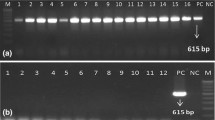Abstract
Yellow leaf (YL) of sugarcane caused by Sugarcane yellow leaf virus (SCYLV) is a serious disease affecting production and productivity in many ruling sugarcane varieties in India, especially in coastal region of Andhra Pradesh state, causing losses ranging from 60% in the first crop to 100% in the ratoon crop. During 2013–2015 seasons SCYLV indexation of meristem tip culture derived sugarcane plantlets as well as usual seed canes planted field varieties was carried out using DAS-ELISA and RT-PCR at RARS, Anakapalle, India. Both leaf extracts and stem sap samples were used. Sixteen samples out of 20 were positive to DAS-ELISA SCYLV diagnosis with OD 405 values of 0.707 to 1.788, while only 13 samples had the visible disease symptoms out of the 20 samples comprising 13 different varieties. This proved efficacy of DAS-ELISAfor indexing even asymptomatic YL infected sugarcane plants. RT-PCR test also detected the virus in both symptomatic and asymptomatic plants. The detection efficiency was considerably good with samples obtained from the same plant (both stem sap and leaf extract) either with colour change or with OD 405 values proving effective and quick indexing using DAS-ELISA. Further, RT-PCR can be used as a confirmatory test to determine the sensitivity of ELISA. In case of in vitro regenerated sugarcane plantlets, all the samples, both hardening stage plantlets and field grown meristem tip culture derived plants didn’t showed any positive reaction for the virus daignosed by DAS-ELISA with lower OD 405 values of 0.082 to 0.0321compared to disease free field varieties (OD 405 from 0.151 to 0.355) making it as best management option with proper indexing.



Similar content being viewed by others
References
Chatenet M, Delage C, Ripolles M, Irey M, Lockhart BEL, Rott P (2001) Detection of Sugarcane yellow leaf virus in quarantine and production of virus-free sugarcane by apical meristem culture. Plant Dis 85:1177–1180
Comstock JC, Irey MS, Lockhart BEL, Wang K (1998) Incidence of yellow leaf syndrome in CP cultivars based on polymerase chain reaction and serological techniques. Sugar Cane 4:21–24
Korimbocus J, Coates D, Barker I, Boonham N (2002) Improved detection of Sugarcane yellow leaf virus using a real-time fluorescent (TaqMan) RT-PCR assay. J Virol Meth 103:109–120
Moutia JFY, Saumtally S (1999) Symptomology of yellow leaf syndrome and detection and distribution of Sugarcane yellow leaf virus in Mauritius. In Proceedings of International Society of Sugar Cane Technologists 24:451–455
Moutia JFY, Saumtally S (2001) Diagnosis of Sugarcane yellow leaf virus in cane juice and the effect of hot water treatment on its control. In: Proceedings of International Society of Sugar Cane Technologists 25:444.450
Raja Kumar N, Suresh M, Bharata Lakshmi M (2014) Current status of sugarcane yellow leaf disease in Andhra Pradesh. Sugar J 2014:45–47
Rao GP, Gaur RK, Singh M, Viswanathan R, Chandrasena G and Dharamwardhaanhe, NMNN (2001) Occurrence of sugarcane yellow leaf virus in India and Srilanka. In: Proceedings of International Society of Sugar Cane Technologists 24:469–470
Scagliusi SM, Lockhart BEL (2000) Transmission, characterization, and serology of a luteovirus associated with yellow leaf syndrome of sugarcane. Phytopathology 90:120–124
Schenck S, Lehrer AT (2000) Factors affecting the transmission and spread of sugarcane yellow leaf virus. Pl Dis 84:1085–1088
Schenck S, Hu JS, Lockhart BEL (1997) Use of a tissue blot immunoassay to determine the distribution of Sugarcane yellow leaf virus in Hawaii. Sugar Cane 4:5–8
Suresh M, Raja Kumar N, Bharatalakshmi M, Veerabhadra Rao K (2014) Survey for natural occurrence and distribution of diseases of sugarcane in Andhra Pradesh and Telangana states. In: proceedings of national seminar on ICM for increasing cane, sugar and jaggery yields. Andhra Pradesh, India, Pp-181-184
Victoria JI, Avellaneda MC, Angel JC, Guzmán ML (2005) Resistance to Sugarcane yellow leaf virus in Colombia. In: Proceedings of International Society of Sugar Cane Technologists 25:664.670
Viswanathan R (2002) Sugarcane yellow leaf syndrome in India: incidence and effect on yield parameters. Sugar Cane Int 20(5):17–23
Viswanathan R (2004) Ratoon stunting disease infection favours severity of yellow leaf syndrome caused by Sugarcane yellow leaf virus in sugarcane. Sugarcane Int 22(2):3–7
Viswanathan R (2012) Sugarcane diseases and their management, sugarcane breeding institute, Coimbatore, ISBN 978-81-904359-1-8, p 140
Viswanathan R (2013) Sustainable ecofriendly disease management systems in sugarcane production under the changing climate – a review. J Mycol and Pl Path 43:12–27
Viswanathan R (2015a) Varietal degeneration in sugarcane and its management in India. Sugar Tech. doi:10.1007/s12355-015-0369-y
Viswanathan R (2015b) Yellow leaf disease of sugarcane becoming a threatening disease of sugarcane. In: proceedings of the 26th sugarcane R&D workers meet
Viswanathan R, Balamuralikrishnan M (2004) Detection of sugarcane yellow leaf virus, the causal agent of yellow leaf syndrome in sugarcane by DAS-ELISA. Arch Phytopath and Pl Prot 37:169–176
Viswanathan R, Karuppaiah R, Malathi P, Ganesh Kumar V, Chinnaraja C (2009) Diagnosis of Sugarcane yellow leaf virus in asymptomatic sugarcane by RT-PCR. Sugar Tech 11:368–372
Acknowledgements
The authors thank the advisory board members for their valuable suggestions during the study. We are greatly indebted toDr K. Raja Reddy, Director of Research, ANGRAU, Andhra Pradesh, India for providing necessary financial assistance for carrying out the study. We would like to thank Mr. S. Afsar for his technical assistance during the RT-PCR work. Sincere thanks to the Associate Director of Research, RARS, Anakapalle for providing necessary facilities during the period of study.
Author information
Authors and Affiliations
Corresponding author
Rights and permissions
About this article
Cite this article
Madugula, S., Gali, U. Virus indexing for Sugarcane Yellow Leaf Virus (SCYLV) in field varieties and in vitro regenerated plantlets of sugarcane. Australasian Plant Pathol. 46, 433–439 (2017). https://doi.org/10.1007/s13313-017-0505-0
Received:
Accepted:
Published:
Issue Date:
DOI: https://doi.org/10.1007/s13313-017-0505-0




